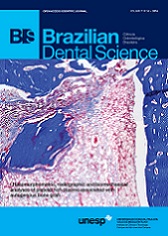Evaluation of the antifungal activity of plant extracts and oral antiseptics against Candida albicans
DOI:
https://doi.org/10.14295/bds.2014.v17i4.1044Abstract
Objective: Oral candidiasis is the most common fungal infection of the oral cavity, and Candida albicans is the most frequently isolated species. Material and Methods: In this study, the potential antifungal effect of extracts from Gossypium hirsutum L., Arctium lappa, Equisetum sp., Cecropia pachystachya Trécul and Pogostemon heyneanus plants were evaluated on non-adhered cells of C. albicans, and the effect of oral antiseptics A (cetylpyridinium chloride 0.500 mg), B (chlorhexidine gluconate 0.12%), C (hydrogen peroxide 1.5%) and D (thymol, eucalyptol, menthol and methyl salicylate) were evaluated on non-adhered cells and biofilms of C. albicans, using turbidimetry and minimal inhibitory concentration (MIC) of the extracts and the maximal inhibitory dilution (MID) of the antiseptics. Results: The most promising results on non-adhered cells were obtained with Cecropia pachystachyaTrécul extracts, with MIC values between 7.81 and 3.91 µg/mL. Antiseptics A and B showed the lowest MID values, between 0.20 and 0.10% (Kruskal-Wallis, p<0.0001). Regarding biofilm inhibition, the MID values found were similar for the tested antiseptics, varying from 50% to 0.20% (Kruskal-Wallis, p=0.6915). Conclusion: These results show that some plant extracts has potential use in the prevention and treatment of oral candidiasis.
Downloads
Downloads
Published
How to Cite
Issue
Section
License
Brazilian Dental Science uses the Creative Commons (CC-BY 4.0) license, thus preserving the integrity of articles in an open access environment. The journal allows the author to retain publishing rights without restrictions.
=================




























